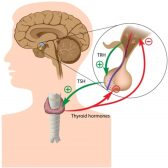Definition
noun, plural: monoblasts
A precursor cell that gives rise to a promonocyte
Supplement
Hematopoiesis is the process of forming new blood cellular elements in vertebrates. It begins with a multipotent stem cell, a hemocytoblast, which gives rise to a common myeloid progenitor cell (CMP). The CMP, in turn, gives rise to granulocyte-monocyte colony forming units (CFU-GM), also called granulocyte-macrophage progenitor. The CFU-GM may partially differentiate into CFU-G (precursor in myelocyte-granulocyte series) or CFU-M (precursor in monocyte-macrophage series). The CFU-GM serves as the precursor for monoblasts and myeloblasts.
The monoblast is a committed progenitor cell that gives rise to a promonocyte. Its size ranges from 12 to 20 µm in diameter. It is considered as the largest blast in the hematopoietic cell lines. Its nucleus is round to oval in shape and often centrally located. It usually has one nucleolus. The cytoplasm is basophilic. When stained, it will have a slightly lighter bluish color. The nuclear to cytoplasm ratio is 4:1 to 3:1.
The monoblasts are the first developmental stage of the monocyte series and are found in the bone marrow.
See also:
- common myeloid progenitor cell
- promonocyte
- hematopoiesis
Related form(s):







